

 Penguins are designed for life in the sea. Some kinds of penguins spend most of their lives in
the water. But they still lay their eggs and raise their chicks on land. Heavy, solid bones act like
a diver's weight belt, allowing them to stay underwater when they need to look for food. Penguins are designed for life in the sea. Some kinds of penguins spend most of their lives in
the water. But they still lay their eggs and raise their chicks on land. Heavy, solid bones act like
a diver's weight belt, allowing them to stay underwater when they need to look for food. Their wings, shaped like flippers, help them "fly" underwater at speeds up to 25 km/h. A streamlined body, paddle-like feet, insulating blubber, and watertight feathers make them at home underwater. They also have a remarkable deep-diving ability. 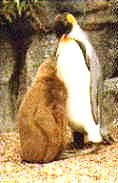 In addition to blubber for insulating warmth, penguins have stiff, tightly packed feathers that overlap to provide waterproofing. They coat their feathers with oil
from a gland near their tail to increase its waterproofing ability. Black and white colouring makes
them nearly invisible to predators from above and below.
In addition to blubber for insulating warmth, penguins have stiff, tightly packed feathers that overlap to provide waterproofing. They coat their feathers with oil
from a gland near their tail to increase its waterproofing ability. Black and white colouring makes
them nearly invisible to predators from above and below.
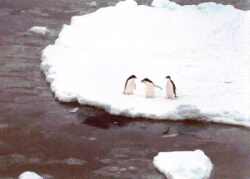 Like most birds, penguins have little or no sense of smell, and only a limited sense of taste.. Their vision appears
to be better when they are underwater. Scientists suspect they may be nearsighted on land.
Like most birds, penguins have little or no sense of smell, and only a limited sense of taste.. Their vision appears
to be better when they are underwater. Scientists suspect they may be nearsighted on land.
Penguins are considered to be the most social of birds. Rookeries may contain thousands of individuals. As many as 24 million penguins visit the Antarctic continent. Even at sea, they tend to swim and feed in groups. 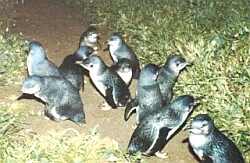 Most species of penguins build nests, but the nests may consist only of a pile of rocks or scrapings or hollows in the dirt. Emperor penguins build no nests; they hold the egg on top of their feet under a loose fold of skin called the brood patch. 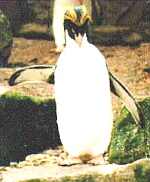 All 17 species of penguins live south of the equator. Penguins live along the
western and southern coasts of South America, the tip of Africa, southern Australia, New Zealand, and all
around Antarctica. One species, the Galapagos penguin, lives on the equator All 17 species of penguins live south of the equator. Penguins live along the
western and southern coasts of South America, the tip of Africa, southern Australia, New Zealand, and all
around Antarctica. One species, the Galapagos penguin, lives on the equator Seven kinds of penguins visit Antarctica, but only two species, the Adelie and Emperor penguins, breed exclusively there. Penguins are the only birds that migrate by swimming. They may migrate up the west or east coasts of South America, as far north as Chile or Rio de Janeiro in Brazil. 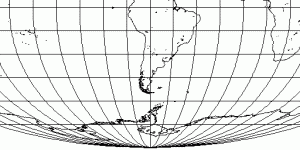  |